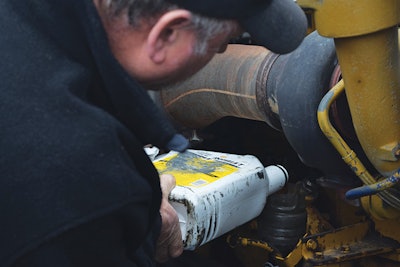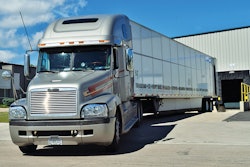PARTNERS IN BUSINESS TABLE OF CONTENTS »

Routine PM will save money over time and help determine when to trade
Preventive maintenance can be expensive, but neglect is even more costly. Systematic PM saves you money in the long run by reducing the chances of equipment failure on the road and reducing time lost to repairs. It also helps reduce the severity of failures if they do occur. Some industry estimates say preventive maintenance can cut breakdown costs in half, and a properly maintained engine will last much longer and also use less fuel.
Nearly all owner-operators change their oil often or use oil analysis to determine precisely when to change if at more distant intervals. Also important is using quality oil and filters, as well as timely coolant servicing (including system flushing), because these practices will help make an engine last longer. Using synthetic transmission and axle lubes and changing at required intervals also will help the life of those components.
Don’t neglect other less-familiar practices. Adjusting the overheads after break-in and then at the required infrequent intervals saves fuel, reduces oil sooting and wear, and is likely to prolong the life of both valves and injectors. Replacing injectors before combustion gets too dirty also will prolong life. Using quality fuel filters will, in turn, prolong injector life. Various long-life antifreeze options, such as extended life coolants and coolant filters that add supplemental coolant additives on a controlled basis, should be considered even though the initial cost may be higher.

A simple maintenance plan that doesn’t require technical skill and special equipment will include tires, engine oil, wipers, lights, filters, coolant and belts/hoses. A more technical PM will include brakes, drive axles, wheel seals, transmission, batteries, exhaust, driveline, suspension, steering, clutch and engine.
AN OUNCE OF PREVENTION
Become familiar with every inch of your truck, and know which components can fail and under what circumstances. You don’t have to be a mechanic, but you should be familiar with a truck’s mechanical operation and how systems interact. Manufacturers recommend a standard PM schedule for every model. The Technology & Maintenance Council of the American Trucking Associations also provides PM guidelines for tractors and trailers. Follow these schedules diligently, and you’ll head off a lot of trouble.
Daily pre-trip inspections, required by the U.S. Department of Transportation, can help identify problems before they become emergency situations. A leaking differential should be repaired before the lubricant loss causes component failure. Early warning signs found by engine or driveline component oil analysis can alert you to serious problems before costly troubles occur. If you have a truck with more than 300,000 miles, consider running a dynamometer test once a year.
Always look for common problems such as seal leaks, loose bolts, chafed wires and hoses, improper adjustments and worn, broken or missing parts. If you cannot recognize these problems, have a qualified technician inspect your rig every six months or even more frequently. An alternative is having lubrication service done at a dealer or truck stop where experienced technicians will look for problems as they work.
The same can be said for maintaining a trailer. For a dry van, check the suspension during pre- and post-trip inspections, perform a pre-load adjustment and annual inspection on the bearings, check the brake lines regularly, and check tire inflation and wear regularly. Also replace the work scuff liner to protect the trailer walls, check the roof during pre- and post-trip inspections for holes and leaks, inspect the threshold plate often, and inspect the floor to spot weak spots or small holes.
BEGIN AT THE DEALER
The best time to start a regular PM program is when you’re buying your truck. If the dealer doesn’t volunteer detailed information on maintenance, ask for it. A good dealer is happy to give advice about oil changes, lube and filter replacement, and other maintenance. Take advantage of your leverage before you buy to get all the information you can. Manufacturers’ websites often offer detailed information.
Separate warranties often are written on the engine, transmission and other components because they are supplied by different entities. Find out the duration of the warranties and what it will take to maintain their validity. You might want to consider extended warranties when available.
Choose a dealer carefully. Make sure its service department has the technicians and equipment to handle major repairs and that they have a helpful attitude. Talk to the parts and service managers, and form a relationship. From there, take the same relationship-building approach to local tire and engine shops, an alignment shop and an air-conditioning shop. Dealing with pros who specialize in one maintenance item is key to holding costs down in the long term. Take time to let the service manager or even the owner of the shop know your goals and plans. Ask their advice about maintenance scheduling.
Do things such as occasionally taking pizza to the mechanics, which can go a long way toward building a relationship with the people who maintain your truck. Also compliment the work once in a while instead of complaining that everything is too expensive. Another way to build relationships is through referrals; if you’re happy with a shop’s work, spread the word to others.
KEEP GOOD RECORDS
Only with complete and accurate records can you track the work done on your truck and prove that required work has been done. Committing every shop visit to paper and creating a calendar of scheduled visits will pay off. You also should keep a schedule of future work to be done. This schedule will help you avoid overlooking something vital.
Devise your own maintenance service report, and use it to keep a record of every dollar you spend on your truck. Keep receipts on repairs. Keep old parts in case of a warranty dispute. When you use the truck service report, note all warrantable purchases and repairs, and include a record of your out-of-pocket expenses such as cab fares, meals and motel stays related to time lost due to repairs. Otherwise, you won’t be able to file warranty claims properly, and your profits will suffer.
Good maintenance records can help you determine average miles per gallon, expenses on a per-mile basis and other key benchmarks helpful in cutting costs. They also can help you spec your next truck.
TIME TO TRADE
Maintenance costs typically rise in the third and fourth ownership years. Fifth-year costs often drop because the truck needs certain work in its fourth year that isn’t required the next. However, the cumulative cost of maintenance — your average cost per year since you took ownership — and your cost per mile still increase each year.
No matter how rigorous your PM efforts, the time will come when you’ll spend more on maintenance than you would for a new truck. How will you know when that time comes? Your maintenance records will tell you.
Create a maintenance budget, and track your maintenance expenses. When they rise to a point that seems excessive, check with your business services provider, who can help you determine how much your fuel, oil and maintenance costs have increased due to the truck’s age.
Your insurance agent can help determine how an equipment upgrade will affect your premiums. Your financing source can discuss various options for the purchase of a new truck, and your accountant can explain potential depreciation benefits that would accompany a new purchase.
Industry experts say you should consider replacement when your fuel mileage drops 2 mpg or more in spite of conservation efforts, or if truck technology develops to the point that a new truck would get an additional 2 mpg. Another indication to trade is when your total maintenance costs reach 15 percent of your gross revenue.
As a rule of thumb, consider a new purchase when the principal, interest, maintenance and operating costs of an old vehicle are higher than the comparable costs attached to a new vehicle. The estimated resale value of the old vehicle, coupled with any manufacturer’s incentive on a new vehicle, may offset the higher cost of a new vehicle’s principal and interest. At this point, a trade makes sense.
WAYS TO SAVE MONEY ON MAINTENANCE
When asked why they’ve done a poor job of preventive maintenance, too many owner-operators say they were trying to save money. But there are many ways to save money on maintenance without skimping and courting disaster.
STAY ON SCHEDULE. Plan your maintenance schedule as thoroughly as you plan this week’s haul, and stick to it.
PLAN FOR EMERGENCIES. A front tire with a nail in it, multiple lights out because of a short circuit, or a suddenly failed brake lining might put even the most maintenance-savvy owner-operator out of commission – or out of service, if a DOT inspector finds the problem first. The industry’s top truck, engine, tire and certain other manufacturers have created 24/7 help centers accessible via a toll-free number or proprietary smartphone application. These centers can put you in touch quickly with the nearest service outlet for emergency assistance.
Independent breakdown services offer similar assistance. Two widely used services are the FleetNet America (www.fleetnetamerica.com) and National Truck Protection (www.ntpwarranty.com) service networks. The National Truck & Trailer Services Breakdown Directory (www.nttsbreakdown.com) is available to search for services in particular areas.
CATCH OVERLOOKED ITEMS EARLY. Timely fixes to these problems can reduce thousands of dollars a year in operational costs by helping avoid breakdowns and providing better service to your customers.
- Charge air cooler. The CAC sits in front of the radiator and looks like a radiator. It is designed to cool superheated air from the turbo before it gets into the intake manifold for more efficient combustion.
- Seeing a water leak from a radiator is easy, but your CAC needs to be pressure-tested to find leaks. You can make or purchase a test kit, or have it done at any engine shop. Engine manufacturers differ as to how much CAC pressure loss is acceptable, usually 5 to 7 pounds in 15 seconds. But given the immediate drop in fuel mileage a leaky CAC causes, it makes sense to replace a unit that leaks just 2 pounds in 15 seconds. At that level, at 2,500 weekly miles at 6 mpg and $3.50 per gallon for diesel, you’d be losing $112 a week.
- Crankshaft damper. Most engine shops will tell you this doesn’t need to be replaced. They don’t even replace it on an in-frame. This is a mistake. The crankshaft damper, designed to reduce torsional twisting from the force of the connecting rods being driven down by combustion, wears out. Consequently, engine force and vibration are not transmitted throughout the entire frame and driveline. This leads to many problems, not the least of which is driver fatigue.
Maintenance problems run the range of broken alternator brackets, broken air-conditioning brackets, clutch and driveline problems and even loose or faulty electrical connections. There is no way to inspect a crankshaft damper: Replacing it at 500,000 miles is recommended to avoid problems. It will cost $700 to $1,000, more in some engines.
- Flexible rubber fuel lines. These can deteriorate internally with no visible wear or damage. Internal deterioration can cause lines to swell and restrict fuel flow, triggering fuel-mileage declines and power loss.
Trucks with fuel mileage issues can benefit from line replacement ($300 to $400) to the tune of 0.3 to 0.4 mpg. If your truck has more than 700,000 miles and an unexplained loss in mpg, it would be recommended. - Factory mufflers. These can cause exhaust restrictions from day one. The longer they’re used, the more soot buildup you see in the muffler itself, and the more exhaust restriction is created.
Restriction robs your engine of performance, power and mpg. You can install a high-performance flow-through muffler on most trucks for less than $200, and your return on investment is nearly immediate. You’ll also notice better throttle response.
- Shock absorbers. When shocks are worn, it can lead to excessive vibration, irregular tire wear and driver fatigue. Many experts recommend replacing shocks every time you replace tires.
BUY OIL IN BULK. The do-it-yourself oil change is a standard for many owner-operators, especially those with their own authority. A one-truck operator can save $200 or more a year by moving from gallon jugs to 55-gallon drums for oil purchases, assuming 125,000 miles per year with an oil change every 25,000 miles. A 10-truck fleet can save almost $3,000 a year by changing from gallon jugs to bulk delivery in a tank. A first step in determining whether buying bulk oil makes sense for you is to contact a local distributor and explore pricing.
Disposal is normally an associated cost, but if you live near an oil-recycling refinery, you might be able to sell your waste oil. Some small fleet shops use waste oil to heat their facilities.
TIPS ON DOING IT YOURSELF
While your free time is valuable, every maintenance job you can do yourself is a job you don’t have to pay someone else to do. Common do-it-yourself jobs include fluid and filter changes, as well as routine work on relatively simple components such as wipers, lights, belts and hoses.
The basic rules always apply:
- Get expert advice for any new project, and be sure you aren’t violating warranties.
- If you’re not comfortable doing any job, take it to the shop.
Here are some cost breakdowns for a few common jobs:
GREASING. Greasing is simple and inexpensive. You can purchase a high-quality lever-action grease gun, grease and wipes for less than $50. Your cost for each job: About $10.
Shop cost: $35 to $50. Time: 45 minutes.
CHANGING FUEL FILTERS. This doesn’t require many tools, but learning the proper technique is important, so consult your owner’s manual. You’ll need a band clamp of appropriate diameter for fuel filters, a catch pan and a small container of fuel. Your cost: $20 per job. Shop cost: $25 to $30. Time: 30 minutes.
CLEANING CONNECTIONS AND CABLES. Special battery terminal cleaners are inexpensive, and other connections can be cleaned with sandpaper or steel wool. Your cost: $10 per job. Shop cost: $80 to $100. Time: One hour.
INSPECTING COOLING SYSTEM. To check your system, buy test strips and measure antifreeze concentration and the level of anticorrosion additives. Your cost: About 20 cents per test for one test strip. Shop cost: $20. Time: 15 min.
DEALING WITH DEALER SERVICE
Many longtime owner-operators have had at least a minor conflict with a dealer over a repair. Whatever the problem, never underestimate the need for effective communication. As long as you’re talking to someone, a compromise is possible.
BASIC STEPS
- Don’t just show up and demand instant service. You’re hardly the only one with a “hot load.” Making an appointment is ideal.
- Make accessible your complete service and warranty records, and never tell the dealer what to fix. Instead, explain all you know about the problem, and if possible, take a service person on a test run to recreate conditions.
- If diagnosis is a problem, ask dealer personnel to discuss the issue with factory service people. If local technicians are too busy, call the factory representatives and ask them to assist the dealer or allow you to relay relevant information.
- When a problem is not identified readily, authorize an hour or two of labor for diagnosis. It’s cheaper than experimenting with repairs and more likely to yield results.
- If speaking to a service representative is a dead end, appeal to the service manager, dealer managers and ultimately the owner. Failing that, a factory representative might be able to influence the outcome. Understand that the manufacturer cannot force the dealer to do anything.
- Even if all else fails, suing can be expensive and is not likely to succeed unless the dealer clearly is violating the terms of a warranty, disobeying an applicable law or acting in bad faith.
GENERAL TIPS
- Work through the selling dealer, who has a greater motivation than other dealers to do warranty work or go to bat for you with the factory.
- Keep your cool, and demonstrate a positive attitude. No one wants to cooperate when they’re treated rudely
- Having a good long-term relationship with dealer personnel will help. Your best leverage is the ability to take your steady business elsewhere.
.
Download the entire Partners in Business Manual
Chapter 1: Becoming your own boss
Chapter 2: Bookkeeping and business analysis
Chapter 3: Understanding your revenue and costs
Chapter 5: Controlling fuel costs
Chapter 6: Controlling tire costs
Chapter 8: Income tax and other taxes
Chapter 9: Choosing a business structure
Chapter 10: Truck buying, leasing, financing
Chapter 11: Choosing a trailer
Chapter 12: Maintaining your equipment
Chapter 13: Choosing a carrier
Chapter 14: Computers, mobile devices and the internet
Chapter 15: Staying compliant and safe
Chapter 16: Trucking insurance
Chapter 17: Health and income insurance
Chapter 19: Saving for yourself











